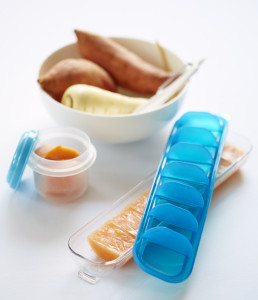 Perhaps your baby is approaching six months old and you’re starting to think about making your own baby food. Or possibly, your little one has been on solids for a little while now, but you’ve been using jars and pouches of pre-made purees and mashes because you think making your own baby food is just too hard! The truth is, making your baby’s food is very easy to do, and there are loads of benefit
Perhaps your baby is approaching six months old and you’re starting to think about making your own baby food. Or possibly, your little one has been on solids for a little while now, but you’ve been using jars and pouches of pre-made purees and mashes because you think making your own baby food is just too hard! The truth is, making your baby’s food is very easy to do, and there are loads of benefit
Why Is Homemade Baby Food A Good Idea?
- Nothing beats homemade when it comes to good nutrition. When you make baby purees and mashes, you choose the foods, herbs and spices that go in (and those that don’t).
- It will save you money. You can buy seasonal vegies when they’re cheap, or use a small portion of the family meal to puree or mash for your baby.
- It’s better for the environment. Don’t buy disposable jars, packets and pouches – make batches of baby food at home, then freeze in cubes or reusable pouches, and reduce waste.
- You can cook according to your baby’s taste. There’s no end to the combinations and flavours you can offer your baby – and variety is often the key to encouraging good eating habits.
How To Make Baby’s First Foods At Home
Banana, peach, avocado or other soft fruit
- Peel and remove seed.
- Use the back of a fork to mash, adding a little breast milk, formula or cooled boiled water, until smooth and thin enough to suit your baby.
Apple, pear, pumpkin, carrot or other hard fruit and vegetables
- Peel, core and remove seeds.
- Chop into even-size pieces (so they take the same amount of time to cook through evenly).
- Place in a saucepan and add 1-2 tablespoons water. Cover with a lid and heat on medium. Cook until tender. Cool slightly.
- Use a benchtop blender, food processor, stick blender or the back of a fork to puree or mash, adding a little breast milk, formula or cooled boiled water, until smooth and thin enough for your baby.
Making Food For Older Babies
As your baby gets older, he’ll be ready to try new foods, like meat, grains, cheese and a wider variety of fruits and vegetables. The easiest and most cost-effective way to introduce these foods to your growing baby is to cook an extra piece of meat or more vegies with the family meal, and set them aside to puree or mash with a little breast milk, formula or water.
You can also start to add herbs, spices and flavours to the purees you’ve already been making for months – try cinnamon sprinkled into the pot when cooking apple or pear; grate some tasty cheese into broccoli puree; or add red lentils to the pumpkin while it’s boiling. Using beef or vegetable stock instead of water can help boost flavours of savoury meals (be sure to use homemade or a salt-reduced variety). And remember – your baby doesn’t need salt, sugar or fats to make her food taste great. Every bite already tastes sensational to her tiny tastebuds!
